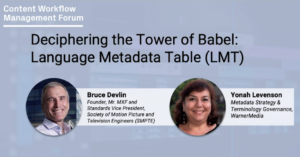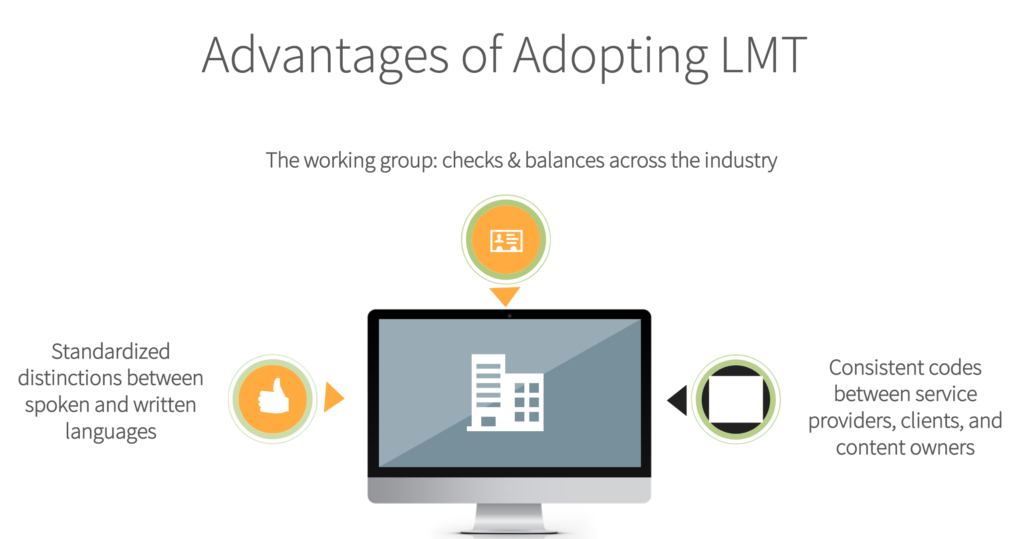M+E Daily

LMT Helps M&E Companies Decipher the Tower of Babel
Story Highlights
Language codes are a major challenge to broadcast media and entertainment organisations but the Language Metadata Table (LMT) provides a way for them to overcome that obstacle, according to Yonah Levenson, manager of metadata strategy and terminology governance at WarnerMedia and co-chair of LMT.
There are “lots of languages everywhere,” she said Feb. 25, showing an image of the Tower of Babel, during the Language & Metadata breakout session “Deciphering the Tower of Babel: Language Metadata Table (LMT)” at the Content Workflow Management Forum, “M&E’s Premiere Localisation Event.”
Around the world, “people speak different languages,” she noted. “You don’t know what they’re saying and we have this problem in the industry where there really hasn’t been a definitive, unified standard of language codes,” she explained.
 That led to the creation of LMT at HBO in 2017 to make sure there was a unified source of reference for language codes, she said. She recalled being in a meeting in which she and others at the company, now part of AT&T-owned WarnerMedia, were trying to decide what code to use for Latin American Spanish. They did research and found out “there were at least four-five different codes being used just within HBO,” she noted.
That led to the creation of LMT at HBO in 2017 to make sure there was a unified source of reference for language codes, she said. She recalled being in a meeting in which she and others at the company, now part of AT&T-owned WarnerMedia, were trying to decide what code to use for Latin American Spanish. They did research and found out “there were at least four-five different codes being used just within HBO,” she noted.
“Something that I thought would just take a couple of months ended up taking 16 months because it was that complicated to make sure we had covered all the languages,” she told viewers.
LMT has expanded and is now being used across the media and entertainment industries — and it also is applicable really for anybody that needs a language code, she said.
It started with 128 languages and MESA serves as its sponsor, she noted, adding LMT was presented publicly in 2018 at a MESA event. A working group was formed that year and LMT version 1.0 was published that year also.
They are up to LMT version 3.3 now and the number of languages has grown to “239 languages and we’re growing,” she said, adding: “There’s about another 100 to 150 candidate languages that are being researched and we’re working on that.”
The LMT codes can be applied to audio and timed text for content, visual or written languages, accessibility for the visually and hearing impaired, rights and licensing localisation and distribution territories.
LMT “takes all that guesswork away” when trying to decide what language to use, Levenson said.
Advantages of adopting LMT include the ability to identify and have a language code for the distinctions between the spoken and written languages, as well as the localisation and consistent codes between service providers, clients and content owners.
 An LMT committee determines what languages and codes to include and makes sure there are use cases. And the LMT working group provides “checks and balances across the media and entertainment industry,” she said, explaining that by using LMT: “Everybody knows what to deliver and what to expect. It just takes away the guesswork and it improves communications.”
An LMT committee determines what languages and codes to include and makes sure there are use cases. And the LMT working group provides “checks and balances across the media and entertainment industry,” she said, explaining that by using LMT: “Everybody knows what to deliver and what to expect. It just takes away the guesswork and it improves communications.”
LMT use cases include: the licensing of international content, distributing non-English content, accessibility requirements, end-user localization preferences, audio, closed captions, burned in/forced narratives, rights, acquisition, distribution and electronic sell-through.
There had been 139 language codes and LMT “takes away the ambiguity” of the existing Internet Engineering Task Force (IETF) BCP 47 language tag system that presents “over 40,000 ways to combine the codes,” according to Levenson. After all, especially if you are new to the industry, without LMT, how are you going to determine which one of those 40,000 codes to use on a project? It is much easier to just go to a table and get your answer, she said.
The Roles of MESA, SMPTE and Other Organisations
The LMT group has regular meetings to stay current, Levenson went on to say. MESA was the original sponsor of LMT. However, “as we’ve progressed, we found that it’s really helpful to be partnering with a true standards body” and the Society of Motion Picture and Television Engineers (SMPTE) “has become our partner and they work on the tools and infrastructure,” she said.
Standards partners that LMT works with include the Entertainment Identifier Registry (EIDR), InterSociety Digital Cinema Forum (ISDCF) and MovieLabs.
This work is “really important – it’s global,” said Bruce Devlin, standards VP at SMPTE and founder of Mr MXF.
A new project is looking at two specific things with LMT, he said: How to publish it but, “more importantly,” to make certain there is “good global consistency in all the different standards groups that might want to come in and add values into this… we have to build a thing called a control document, which defines what the rules are for people within this group to update the register.”
SMPTE is “working really hard with MESA to make certain that that is sensible and it gives everybody a fair crack at the whip to make certain that we get the best possible list that we can,” he told viewers.
Click here to access video of the presentation. Click here to download the presentation slide deck.
The Content Workflow Management Forum was produced by MESA, the Audio Business Continuity Alliance, Content Localisation Council, Smart Content Council, and the Hollywood IT Society, with sponsorship by Iyuno Media Group, Richey May Technology Solutions, Whip Media Group, Deluxe, Digital Nirvana, Meta, Vubiquity, EIDR, Keywords Studios, Los Angeles Duplication & Broadcasting, Nexus TV, OOONA, Signiant and Titles-On.









